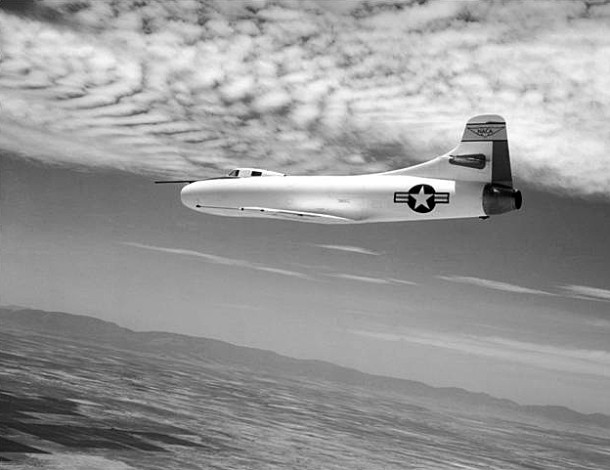
Sixty-two years ago this month, NACA test pilot A. Scott Crossfield piloted the United States Navy/Douglas D-558-I Skystreak transonic research aircraft on the last of 230 flights. The type’s final test flight was flown on Wednesday, 10 June 1953 at Edwards Air Force Base, California.
Flight near and beyond the speed of sound is characterized by large variations in flowfield density. Variable density flow is known as compressible flow. A key compressible flow phenomenon is the formation of shock waves which result when the supersonic freestream is deflected or turned by the presence of the aircraft.
As every aircraft has a distinct shape, it also has its own distinct shock wave system. The topology and strength of this 3-dimensional shock wave system significantly affects aircraft flight performance, stability and control, handling qualities, airframe buffet characteristics and airloads.
Following World War II, the United States initiated a sustained flight research effort in the realm of transonic and supersonic flight. In league with the US military and the National Advisory Committee For Aeronautics (NACA), the American aeronautical industry designed and built a variety of aircraft used to conduct flight research during the 1940’s and 1950’s. These experimental aircraft were the first of the fabled X-planes.
In June of 1945, the Douglas Aircraft Company was awarded a contract by the United States Navy (USN) to build a total of six (6) flight research aircraft. These vehicles would be used in a two phase flight research program. Phase I was devoted to transonic flight testing while Phase II would investigate supersonic flight. The Phase I aircraft was known as the D-558-I Skystreak while the Phase II airplane was called the D-558-II Skyrocket.
The USN/Douglas D-558-I Skystreak measured 36-feet in length and had a wingspan of 25-feet. The straight-winged aircraft weighed a bit over 10,000 pounds and was powered by an Allison J35 turbojet rated at 5,000 pounds of sea level thrust. The aircraft was single place and employed ground take-off. Three (3) copies were made; BuAer tail numbers 37970, 37971 and 37972.
Later painted white to improve visibility, each Skystreak external airframe was originally painted a stunning red. This led to the type’s nickname of the “Crimson Test Tube”. Other nicknames included the “Flying Stove Pipe” and the “Supersonic Test Tube”. This last moniker is misleading in that the aircraft could only go slightly supersonic and only in a dive.
Along with its D-558-II companion, the D-558-I helped write the book on transonic aircraft aerodynamics. The D-558-I Skystreak acquired vital flight data relative to aircraft stability and control, handling qualities, airframe buffet and airloads. Those data are used to support aircraft design efforts down to the present day.
Pilots reported that the D-558-I exhibited generally favorable handling qualities. However, the Skystreak had its share of peculiar transonic aerodynamic attributes as well. Wing drop due to asymmetric shock-induced separation was one such phenomenon. Reduced control effectiveness and severe lateral-directional oscillations, both due to shock wave-induced flow separation at high Mach number, were exhibited as well.
Beyond 0.94 Mach number, the D-558-I experienced a phenomenon known as “Mach Tuck”. This condition is attributable to an aftward shift in the aircraft transonic center-of-pressure location as the pressure pattern over the aircraft changes with Mach number. This is equivalent to an increase in nose down pitching moment. Taken to extremes, the “Mach Tuck” flight condition is unrecoverable due to an exceedance of pitch control authority.
Approximately 15 men flew the D-558-I Skystreak 230 times between April of 1947 and June of 1953. One aircraft and one pilot was lost during the type’s flight research program. NACA test pilot Howard Lilly died and aircraft 37971 was destroyed when a J35 turbojet compressor blade failed during take-off on Tuesday, 25 November 1947.
Today the surviving aircraft are publically displayed in tribute to the Skystreak’s contributions to aeronautics. Tail No 37970 is displayed at the Naval Air Museum in Pensacola, Florida while Tail No. 37972 can be viewewd at the Carolinas Avaiation Museum in Charlotte, North Carolina.

